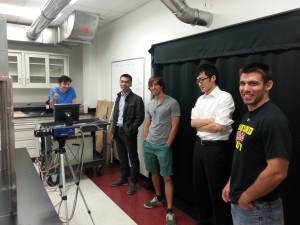Invited Talk by Xinyan Huang, Imperial Haze Lab, on Smoldering Wildfires!

Shown here from left to right is Pietro, Xinyan, Colin, Zhao and Dan watching a new experiment using PIV on fires.
We were happy to host Xinyan Huang, from Dr. Guillermo Rein’s Haze Lab at Imperial College, London this week who presented some exciting new research on Smoldering Wildfires!
Smoldering Wildland Fires: Ignition, Spread and Extinction
Xinyan Huang
Department of Mechanical Engineering, Imperial College London
11:00 AM Wednesday, August 20th
3106 JM Patterson Building
Fire Protection Engineering Conference Room
Abstract
Smoldering fire is the slow, low-temperature, flameless burning of porous fuels and the most persistent type of fire. Smoldering megafires in natural deposits of peat are the largest and longest burning fires on Earth, and contribute considerably to global greenhouse gas emissions, and regional haze events in Southeast Asia, North America and Northeast Europe, but is poorly understood. In this talk, I will start with proposing a multistep heterogeneous kinetic scheme to describe the drying and decomposition of peat in smoldering wildfires. The kinetic scheme is able to explain the thermogravimetric data for multiple peat samples, and the possibility of alternative kinetic scheme is discussed. Then, a comprehensive 1-D model of a reactive porous media, using the open-source code Gpyro and complex kinetics, is established to investigate the smoldering fires of natural fuels. With this model, the roles of the moisture and inert contents on the ignition probability is investigated, and some ignition experiments in the literature are successfully explained. The model also predicts that the critical moisture content of extinction in fire spread is different from the critical value of ignition, and peat fire can spread at a super critical moisture content. In addition, the depth of burn is predicted and compared with experiment in the field. This is the first time that a smoldering peat fires is simulated with a physics-based model and complex chemistry, thus helping to understand this important natural and widespread phenomenon.
Short Bio
Xinyan Huang is currently a second-year PhD student at the Department of Mechanical Engineering, Imperial College London, funded by Imperial Exceptional Oversea Scholarship. His PhD research with Dr Guillermo Rein seeks the fundamentals of smoldering wildfires which are a non-conventional source of greenhouse gas emissions, are the cause of large haze episodes and destroy valuable ecosystems. Before that, he got a BS in Thermal Science at Southeast University, China (2010) and a MS with Professor Forman Williams at University of California at San Diego (2012). He has also worked at Hokkaido University, Singapore National University, and SKLFS China for multiple projects. His research interests include, chemical kinetics and reduction, flame instability and cool flame, smoldering and haze phenomena, micro-gravity combustion and space fire safety, flame spread and ignition/extinction theory, and sustainable energy technology.
default

